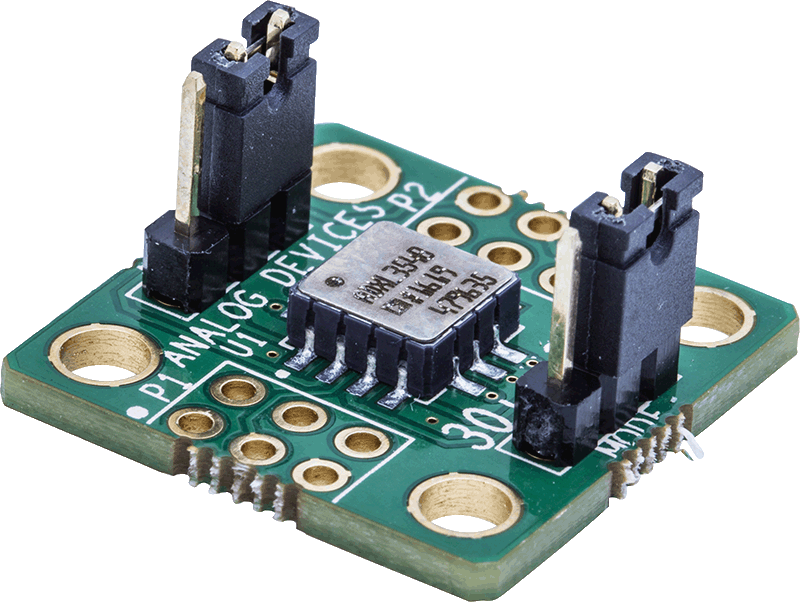ADXL356
RECOMMENDED FOR NEW DESIGNSLow Noise, Low Drift, Low Power, 3-Axis MEMS Accelerometer
- Part Models
- 9
- 1ku List Price
- Starting From $36.83
Overview
- 0 g offset vs. temperatures (all axes): 0.75mg/°C maximum
- Ultralow noise spectral density (all axes): 75 µg/√Hz
- Low power, VSUPPLY (LDO regulator enabled)
- ADXL356 in measurement mode: 150 µA
- ADXL357/ADXL357B in measurement mode: 200 µA
- ADXL356/ADXL357/ADXL357B in standby mode: 21 µA
- ADXL356 has user adjustable analog output bandwidth
- ADXL357/ADXL357B digital output features
- Digital SPI and limited I2C interfaces supported
- 20-bit ADC
- Data interpolation routine for synchronous sampling
- Programmable high- and low-pass digital filters
- Integrated temperature sensor
- Voltage range options
- VSUPPLY with integral regulators: 2.25 V to 3.6 V
- V1P8ANA, V1P8DIG with internal LDO regulator bypassed: 1.8 V typical ± 10%
- Operating temperature range: -40°C to +125°C
- 14-terminal, 6 mm × 5.6 mm × 2.2 mm, LCC package ADXL356-EP supports defense and aerospace applications (AQEC standard)
- Download ADXL356-EP Data Sheet (pdf)
- Military temperature range: −55°C to +125°C
- Controlled manufacturing baseline
- One assembly/test site
- One fabrication site
- Product change notification
- Qualification data available on request
- V62/18610 DSCC Drawing Number
The analog output ADXL356 and the digital outputs ADXL357 and ADXL357B are low noise density, low 0 g offset drift, low power, 3-axis accelerometers with selectable measurement ranges. The ADXL356B supports the ±10 g and ±20 g ranges, the ADXL356C supports the ±10 g and ±40 g ranges, and the ADXL357 and ADXL357B support the ±10 g, ±20 g, and ±40 g ranges.
The ADXL356/ADXL357/ADXL357B1 offer industry leading noise, minimal offset drift over temperature, and long-term stability, enabling precision applications with minimal calibration.
The low drift, low noise, and low power ADXL357 and ADXL357B enable accurate tilt measurement. The ADXL357B is more robust/suitable for tilt sensing in high vibration environments. The low noise of the ADXL356 over higher frequencies is ideal for condition-based monitoring and other vibration sensing applications.
The ADXL357 and ADXL357B multifunction pin names may be referenced only by their relevant function for either the serial peripheral interface (SPI) or limited I2C interface.
Applications
- Inertial measurement units (IMUs)/altitude and heading reference systems (AHRSs)
- Platform stabilization systems
- Structural health monitoring
- Seismic imaging
- Tilt sensing
- Robotics
- Condition monitoring
Documentation
Data Sheet 3
User Guide 2
Technical Articles 8
Product Highlight 1
Solutions Bulletin & Brochure 2
Product Highlight 1
Thought Leadership Page 2
Rarely Asked Question Page 1
Analog Dialogue 5
Webcast 5
ADI has always placed the highest emphasis on delivering products that meet the maximum levels of quality and reliability. We achieve this by incorporating quality and reliability checks in every scope of product and process design, and in the manufacturing process as well. "Zero defects" for shipped products is always our goal. View our quality and reliability program and certifications for more information.
| Part Model | Pin/Package Drawing | Documentation | CAD Symbols, Footprints, and 3D Models |
|---|---|---|---|
| ADXL356BEZ | 14-Lead LCC (6mm x 6mm) | ||
| ADXL356BEZ-RL | 14-Lead LCC (6mm x 6mm) | ||
| ADXL356BEZ-RL7 | 14-Lead LCC (6mm x 6mm) | ||
| ADXL356CEZ | 14-Lead LCC (6mm x 6mm) | ||
| ADXL356CEZ-RL | 14-Lead LCC (6mm x 6mm) | ||
| ADXL356CEZ-RL7 | 14-Lead LCC (6mm x 6mm) | ||
| ADXL356TEZ-EP | 14-Lead LCC (6mm x 6mm) | ||
| ADXL356TEZ-EP-RL | 14-Lead LCC (6mm x 6mm) | ||
| ADXL356TEZ-EP-RL7 | 14-Lead LCC (6mm x 6mm) |
| Part Models | Product Lifecycle | PCN |
|---|---|---|
|
Jul 20, 2022 - 22_0133 Carsem-M as an Alternate Assembly Site for LCC package for ADXL35X Family |
||
| ADXL356BEZ | PRODUCTION | |
| ADXL356BEZ-RL | PRODUCTION | |
| ADXL356BEZ-RL7 | PRODUCTION | |
| ADXL356CEZ | PRODUCTION | |
| ADXL356CEZ-RL | PRODUCTION | |
| ADXL356CEZ-RL7 | PRODUCTION | |
| ADXL356TEZ-EP | PRODUCTION | |
| ADXL356TEZ-EP-RL | PRODUCTION | |
| ADXL356TEZ-EP-RL7 | PRODUCTION | |
|
Aug 9, 2018 - 18_0115 MEMS Die Attach Change for ADXL354, ADXL355, ADXL356, ADXL357 |
||
| ADXL356BEZ | PRODUCTION | |
| ADXL356BEZ-RL | PRODUCTION | |
| ADXL356BEZ-RL7 | PRODUCTION | |
| ADXL356CEZ | PRODUCTION | |
| ADXL356CEZ-RL | PRODUCTION | |
| ADXL356CEZ-RL7 | PRODUCTION | |
|
Jul 13, 2018 - 17_0029 ADXL354, ADXL355, ADXL356, ADXL357 Assembly Transfer to Cirtek and Wire Change |
||
| ADXL356BEZ | PRODUCTION | |
| ADXL356BEZ-RL | PRODUCTION | |
| ADXL356BEZ-RL7 | PRODUCTION | |
| ADXL356CEZ | PRODUCTION | |
| ADXL356CEZ-RL | PRODUCTION | |
| ADXL356CEZ-RL7 | PRODUCTION | |
|
Feb 9, 2018 - 18_0025 Sensor Die Size Change for MEMs Products ADXL354, ADXL355, ADXL356, ADXL357 |
||
| ADXL356BEZ | PRODUCTION | |
| ADXL356BEZ-RL | PRODUCTION | |
| ADXL356BEZ-RL7 | PRODUCTION | |
| ADXL356CEZ | PRODUCTION | |
| ADXL356CEZ-RL | PRODUCTION | |
| ADXL356CEZ-RL7 | PRODUCTION | |
|
May 22, 2019 - 18_0115 MEMS Die Attach Change for ADXL354, ADXL355, ADXL356, ADXL357 |
||
| ADXL356TEZ-EP | PRODUCTION | |
| ADXL356TEZ-EP-RL | PRODUCTION | |
| ADXL356TEZ-EP-RL7 | PRODUCTION | |
This is the most up-to-date revision of the Data Sheet.



